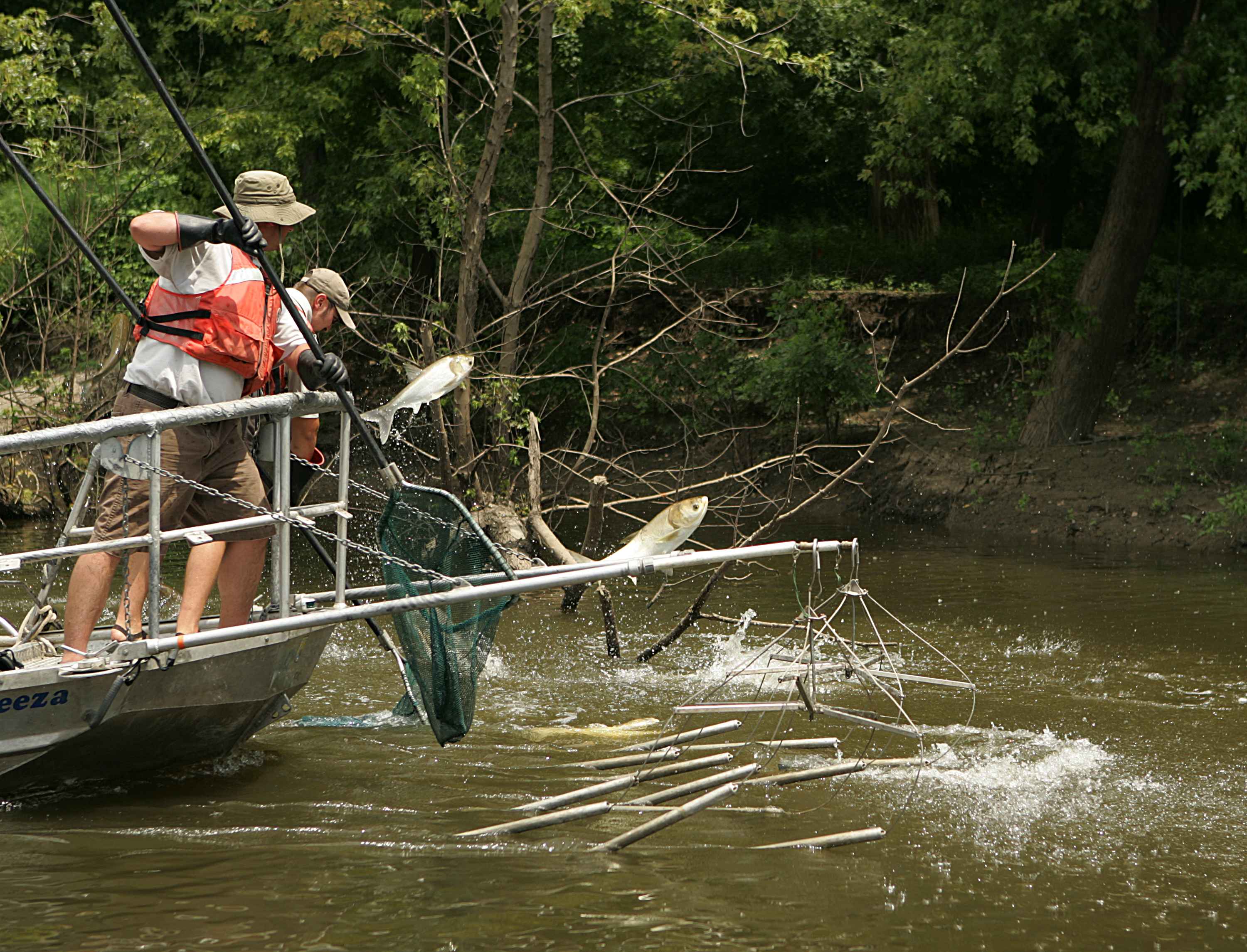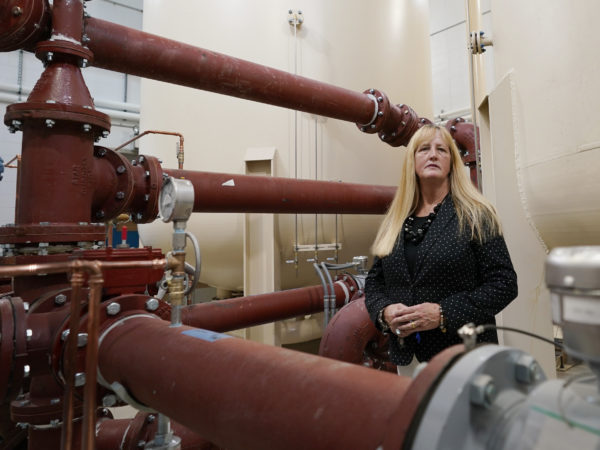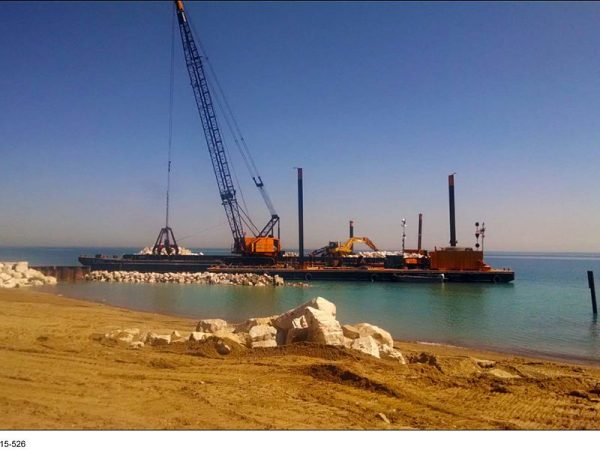
Asian carp are invasive fish that grow fast, jump high and have taken over large swaths of the Mississippi watershed. And now, state and federal governments are worried the Great Lakes are next. On everything from electric fences to contracted fishing programs, NewsHour Weekend’s Megan Thompson reports on efforts to keep them out. Hari Sreenivasan: Just a few weeks ago, the federal government proposed a plan for a nearly $800 million infrastructure project in the state of Illinois. It’s not about maintaining bridges or re-paving highways, but it is about building barriers to defend Lake Michigan from a fish. It’s the Asian carp, a fish that has already wreaked environmental havoc up and down the Mississippi River watershed. NewsHour Weekend’s Megan Thompson has our report. Megan Thompson: Charlie Gilpin Jr. fires up his boat and heads out to fish a stretch of the Illinois river about 100 miles west of Chicago. He’s spent most of his adult life working on the lakes and rivers of the upper Midwest. Charlie Gilpin Jr.: I’m a third-generation commercial fisherman. I’ve been doing it for about 22, 23 years. Megan Thompson: Like a typical fisherman, Gilpin gets an early start. He drives while an assistant sets out the nets. Charlie Gilpin Jr.: Now let’s see if we can scare ’em … Megan Thompson: What comes next — not so typical. Charlie Gilpin Jr.: Go ahead, Doug! Megan Thompson: This is how you catch Asian carp. The loud sounds startle the fish and push them into the nets. The other unusual thing — these fish jump. The flopping, flailing fish are an invasive species wreaking havoc on lakes and rivers across the South and Midwest. Gilpin and the other fishermen out here today are employed by the state of Illinois. Their mission: pull as many carp out of the river as they can. Kevin Irons runs the program. Kevin Irons: So whenever any of these carps are out of balance, there’s too many of them, they’re going to have catastrophic ecological effects. Megan Thompson: There are four types of Asian carp, but bighead and silver cause the most trouble. They reproduce faster than other fish, grow very quickly and can get to over 100 pounds, and they gobble up plankton and algae, pushing out the native fish. The carp were first brought to the Southern U.S. from Asia in the 1960s to help clean ponds and fish farms. But some escaped to nearby rivers and lakes. Joel Brammeier: So places that were once prized fisheries for a fish like small mouth bass or walleye become primarily Asian carp habitat. Megan Thompson: Joel Brammeier heads the environmental nonprofit, the Alliance for the Great Lakes. Brammeier explains that over the last three decades, the carp have moved up the Mississippi and through its tributaries. Today, the “leading edge” of the population hovers about 50 miles from Lake Michigan. The fear now: the carp could get into Lake Michigan, and then into the other four Great Lakes. Their most likely path is a series of canals dug in the Chicago area in the 1800s to connect Lake Michigan to the Mississippi River system. The canals provided new shipping lanes, carried away sewage and were hailed as a great feat of engineering. Joel Brammeier: But it also created a whole set of new problems. Megan Thompson: Brammeier says, Asian carp in the Great Lakes could spell disaster for the region’s environment and economy, which is highly dependent on tourism and sportfishing. Joel Brammeier: We’ve got fish like lake trout and walleye and yellow perch that form the backbone of a $7 billion sport fishery. These fish are the kind that can get pushed out. Megan Thompson: And then there’s that issue of all that jumping. Joel Brammeier: Where they’ve really gotten established, they’ve basically shut down streams and lakes from recreation, because for one, when you powerboat through Asian carp habitat, silver carp in particular jump out of the water, and can actually hit people in the boats. Megan Thompson: Over the last two decades, officials across the upper Midwest have been sounding alarms and spending hundreds of millions of state and federal dollars to try to keep the fish out. Currently, the biggest and most expensive defense lies in the Chicago canal about 25 miles from Lake Michigan. Chuck Shea: We actually have three operating electrical barriers. Megan Thompson: Chuck Shea is a project manager for the U.S. Army Corps of Engineers, which operates a series of specially designed underwater electrical barriers. Chuck Shea: So the electricity is very rapidly turning on and off .. Megan Thompson: Three sets of several 8-ton steel bars send electrical pulses into the water above. Chuck Shea: As a fish comes into the electrical field, it gets a stronger and stronger electrical shock. And most fish will turn around. Megan Thompson: Shea says this is the largest barrier of its kind in the world. The Army Corps says the biggest danger is the risk of electrical shock to boaters who might pass through. Chuck Shea: They should watch any children or pets that are onboard, and everybody should stay away from the edges of the boat. Megan Thompson: The three fences, and a fourth slated for 2021, cost $270 million to build. Operation and maintenance of the barriers — staffed around the clock — cost around $16 million dollars a year. Megan Thompson: Do you ever just look at this and think, oh, my gosh, all of this for some fish? Chuck Shea: Well, it’s more than just fish, though. It’s — there’s an entire ecosystem in the Great Lakes that’s– that’s of concern, and that has great economic as well as environmental benefits. Megan Thompson: Shea says, the barrier’s been successful in protecting those benefits- scientists tag fish downstream and have never seen any tagged fish get through. But Shea admits the system’s not foolproof. Chuck Shea: It would be very difficult for any fish to swim directly through the electrical fields when they are on and operating. But I don’t know that we can say anything in life is absolutely 100% effective. Megan Thompson: In fact, in 2017, an Asian carp was found beyond the barrier, about 9 miles from entering Lake Michigan. In 2010, another carp was caught about 6 miles from Lake Michigan. Carp DNA has also been detected in the waterways, and even in Lake Michigan itself. There’s debate over whether the fish slipped through the barrier, or made it into the waters some other way. The discoveries further stoked regional tensions over the issue. The state of Michigan, with its 3,300 miles of Great Lakes coastline, has long pressured Illinois to do more to stop the carp. In 2009, Michigan and four other states sued Illinois in a bid to shut down the Chicago canals to keep carp out of Lake Michigan. The lawsuit went nowhere and other talk of taking the drastic step of closing the canals has met stiff opposition in Illinois. Because billions of dollars of freight travel through the area’s waterways every year. Del Wilkins: And in this region, you know, we ship probably 25 to 35 million tons annually in the region. Direct and indirect, tens of thousands of jobs are directly involved with this industry. Megan Thompson: Del Wilkins is the President of Illinois Marine Towing, a major shipping company. He agrees Asian carp must be stopped, but not at the expense of the massive barges carrying everything from grain to fuel to cement up and down the rivers. Evelyn Sanguinetti: And we look at the Asian Carp as a threat, as well, to the Lake Michigan region. But let’s understand how we move to be able to mitigate that risk and find a way to have a win, win solution, versus a win, lose solution. Megan Thompson: Evelyn Sanguinetti, Illinois’s outgoing Republican Lieutenant Governor, agrees. She’s helped oversee the state’s battle against Asian carp. Evelyn Sanguinetti: In our waterways, there is commerce. So, that is a balance that oftentimes– we’re– we’re encountering. Megan Thompson: Since those discoveries of carp beyond the electric barrier, the state of Illinois has launched a number of projects to keep them out of the Great Lakes. There are public awareness campaigns and regular monitoring of the waterways to keep tabs on where the fish are. Evelyn Sanguinetti: It goes with that other campaign that we have, which goes something like this, “If you can’t beat ’em, then you eat ’em.” Megan Thompson: That’s right – the state’s trying to get people to eat Asian carp, a fish that Americans have never embraced as food. A program at the University of Illinois serves up more than 10,000 pounds of carp every year in its dining halls. Student: That’s really good. Megan Thompson: But the state program that pays fishermen like Charlie Gilpin Jr to catch as many fish as they can is making the biggest dent. Kevin Irons of the Department of Natural Resources helped launch it in 2010. Kevin Irons: It’s all Asian carp all the time is our little mantra. Megan Thompson: The program’s price tag of just over $1 million per year is covered by the US. Environmental Protection Agency. Nine teams of professional fishermen can each catch up to three tons of carp in a day — sometimes more. Biologists ride along to document the catch. Charlie Gilpin Jr. used to catch and sell buffalo fish in Western Illinois, where he’s from. But then the Asian carp arrived about 15 years ago. Charlie Gilpin Jr.: In those areas you can’t target the fish, the native fish that you used to, because of the abundance of the Asian carp. So we’ve kind of had to join in and– and just catch the Asian carp. Megan Thompson: Gilpin says, before this program, he was struggling to make a living fishing, let alone on Asian carp, which hasn’t caught on widely as food. So this program has helped him out a lot and his father, who’s out here fishing, too. At the end of each day, the fishermen tow their catch to a nearby town. The carp are transferred to huge bins and stored in a refrigerated truck. Anyone can come get them, free of charge. They just can’t be eaten by people, since they went a few hours without being refrigerated. So they’re made into things like fish fertilizer and bait. The day we were there, a pet food maker showed up to gladly take the free ingredients. Brian Wilson: We load up, I got coolers of ice, we’re gonna ice it down, tarp it, I’m gonna take it home and get it processed. Megan Thompson: Since this program started in 2010, the state says it has caught 7.5 million pounds of carp… decreasing the leading edge population by 93%. Megan Thompson: Do you hope someday that you can just stop– stop fishing for Asian carp in this part of the river? Kevin Irons: It’d be great, right? I’m — I’m concerned with people thinking eradication is — is the ultimate goal. It — it’s really, really hard to do. Megan Thompson: And that’s why, there’s a whole new line of carp defenses being planned at the Brandon road Lock and Dam about 10 miles before the existing electric barriers. The Army Corps is proposing to install more electric barriers, underwater sound machines to scare the fish and something called an “air bubble curtain” – to flush out any carp caught between barges traveling through. The state of Illinois has agreed to sponsor the project, reluctantly worried about the costs. Evelyn Sanguinetti: It’s very easy to automatically come to the conclusion that the sky is falling. And so, this is why it’s so important that we not have a knee-jerk reaction to this Video: You can stop Asian Carp from devastating the Great Lakes. Megan Thompson: Meanwhile, the state of Michigan has is gung-ho, even launching a campaign to pressure Illinois to take a stronger stand. Video: All the states need to come together and not make money the issue. The issue is these carp. Megan Thompson: But the money is an issue. A new price tag for the project was announced in November: nearly $778 million – three times the original estimate. Congress must now approve the plan and provide some funding. Previous talks between Illinois and Michigan about sharing the remaining costs are now up in the air, given the new price tag – and the fact that new governors are taking over both states this month. While the politicians sort it all out the fishermen in Illinois continue their work hauling ton after ton of bighead and silver carp. Charlie Gilpin Jr. says he’s proud to be a part of the mission and he even sees a silver lining for what he calls his dying profession. Charlie Gilpin Jr.: But with the abundance of the fish it’s kind of given us another outlet. It’s kinda — it’s kind of a blessing and a curse. It — it may be our savior.Read the Full Transcript




